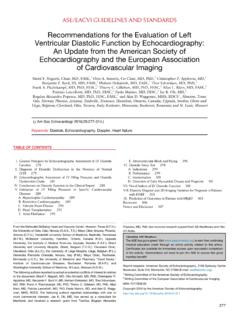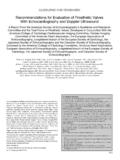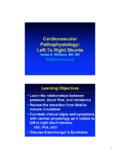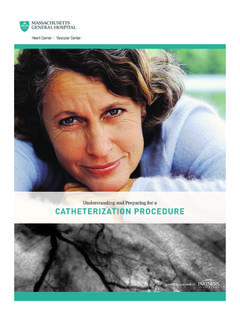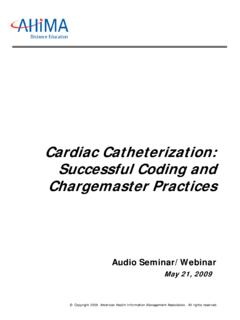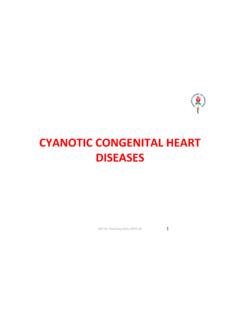Transcription of Spectrum of Aortic Stenosis - American Society of ...
1 Spectrum of Aortic Stenosis : Etiology and Echo QuantificationMartin G. Keane, MD, FASEP rofessor of MedicineLewis Katz School of Medicineat Temple University Review Question #1 What can lead to underestimation of the Aortic valve gradient on echo as compared with invasive hemodynamics at peak instantaneous gradient to peak-to-peak large incident angle to the Aortic to account for high stroke volumeReflect upon the image belowTransesophageal (TEE):Review Question #2 Which of the following statements best describes this Aortic of left & right cor. of left & Bicuspid Aortic Valve (trileaflet) be determinedReview Question #3A patient presents with the following echo findings:LVOT diameter = cmLVOT velocity = 130 cm/sAortic velocity = m/s2D: Moderately calcified AV, Normal LVEF (70%) The Aortic valve area is most likely: be calculated (incongruent units)Basic root structureParasternal Long Axis ViewNormal AVparasternal color DopplerNormal AV M-Modecoaptationin center of Aortic rootNormal AVorientation and openingDiastoleSystoleNRLN ormal AVApical viewsApical 5-ChamberApical Long AxisSpectral Doppler of the AVApical Five ChamberAR jet AS jetBicuspid Aortic Valve Most common congenital anomaly (1-2%) Commissure may be horizontal or vertical Horizontal:Anterior and Posterior leaflets Vertical.
2 Right and left (coronary) leaflets Accel. calcification & premature Stenosis Proximal aortopathy(even in normals) Associated Aortic abnormalitiesBicuspid Aortic ValvePLAX View Doming DiastoleSystoleBicuspid Aortic ValvePSAX view morphologyDiastoleSystoleSystolic ellipsoid orifice identifies as Valve:Other Anomalies associated with ASUnicuspidAoVQuadracuspidAoVAortic StenosisEtiology Senile/Degenerative Calcific Calcification resembles ectopic bone Risk factors similar to those for atherosclerosis Renal dysfunction may accelerate Premature Calcific Bicuspid / Congenital Rheumatic Less common in the United States Less common Type 2 Hyperlipidemia, SLE, Irradiation, Paget s DzCalcific Aortic Stenosis :Reduction in leaflet motionRheumatic Aortic Stenosis :Commissural fusionAortic Stenosis :Physiologic Sequelae Chronic LV pressure overload Myocardial Hypertrophy-Progressive LA dilatation END STAGE: LimitedCardiac Output Systolic Dysfunction Diastolic Dysfunction SYMPTOMS: Dyspnea and Fatigue (often subtle) Typical and Atypical Chest Pressure Syncope Congestive Heart FailureEvaluation of AS: Echo Essentials Valve Anatomy-establish etiology Exclude other forms of LVOT obstruction Severity of Stenosis Physiologic sequelae LV hypertrophy, diastolic fxn, systolic fxn LA dilatation, Pulmonary hypertension Evaluate concurrent disease Proximal aorta and arch Aortic Valve Regurgitation, Mitral DiseaseAortic Stenosis :Assessing SeverityBaumgartner H, et al.
3 JASE (2009) 22:1-23}ASE / EAER ecommend Peak AV Jet Velocity Mean AV Gradient Valve Area by continuity equation Velocity Ratio ( Dynamic Index ) PlanimetryAortic Stenosis :Prognosis of Velocity Variable Rate of Progression Avg ~ m/sec/year High rate of events, even for asymptomatic AS Baseline AoV Peak Jet Velocity, rate of change of velocity and functional status predict clinical outcomeOtto C, et al. Circulation (1997) 95:2262 Aortic Stenosis :Peak Velocity Continuous Wave (CW) Doppler in Apical 5 Chamber View Must be parallel to the ejection jet Confirm Right Parasternal Suprasternal also possible Use highest velocity Avoid feathery signals at tip Piedoff non-imaging probe Decrease gains & adjust baseline24 Aortic stenosisAssessment by Peak Velocity Mild Stenosis : m/s Moderate Stenosis : m/s Severe Stenosis :> m/s Very Severe or Critical Stenosis :> m/sAortic Stenosis :PeakGradient Peak Gradient= 4 (VAV)2 Peak Instantaneous GradientDopplerInstantaneous Gradient vs.
4 Peak to Peak Echo a more physiologic measurement Doppler peak gradient always higher Mean gradient and AVA should correlate Gradients are flow dependentCathAortic Stenosis :Mean Gradient Mean Gradient Integration of velocityover time Estimate * Peak Grad. Correlates with cath Peak-to-Peak gradientAortic stenosisAssessment by Mean Gradient Mild Stenosis : < 20 mmHg Moderate Stenosis : 20 39 mmHg Severe Stenosis : 40 mmHgVelocity and Gradientpitfall:Influence of Cardiac Output High CO = High gradient Aortic regurgitation Hyperdynamic function Low CO = Low gradient Reduced ejection fraction Small ventricular cavity/LVH High systemic vascular resistance/impedance Significant mitral regurgitationAortic stenosisAssessment of Valve Area Normal valve area:= 3 -4 cm2 Mild Stenosis : > cm2 Moderate Stenosis : cm2 Severe Stenosis :< cm2 Critical Stenosis .
5 < cm2 Based on conservation of massFlow within LVOT = Flow across AV LVOT area * VTILVOT= AVA * VTIAV [ * (LVOTrad)2] * VTILVOT= AVA * VTIAV [ * (LVOT radius)2] * VTILVOT= AVAVTIAVC alculation of AV Area:Continuity EquationLVOT cmFlow through LVOTP ulse Wave Doppler Spectral Envelope With samplevolume in LVOT Velocity TimeIntegral (VTI) flow through asingle pointVTI = 19 cmFlow Across the Aortic Valve:Continuous Wave Doppler VTI = 85 cmCalculating Aortic Valve Area AVA = (DiameterLVOT/ 2)2x x VTILVOTVTIAV AVA = ( cm / 2)2x x 19 cm85 cm AVA = cm2 Pitfalls of the Continuity Equation LVOT measurement Diameter is squared -can propagate large error LVOT velocity AV velocity Missing the Peak: use multiple sites / Piedoff Use highest velocity obtained Beware MRDoppler Velocity Index Eliminates errors of LVOT measurement DVI = VTILVOT/ VTIAV Criteria for Severe AS: DVI < flow-independent measure of stenosisPlanimetryof the Aortic ValveAVA = cm2 Planimetry Correlates with invasively obtained areas Flow dependent Difficult to distinguish decreased opening due to LV failure TEE superior -use of color flow area Dense calcification reduces accuracySummaryBaumgartner H, et al.
6 JASE (2009) 22:1-23 WHEN SHOULD I OPERATE? patient has severe Aortic Stenosis !What do I do? Who do I talk to?The Good Old Days:The Symptomatic Cliff Braunwald E, et al. Circulation(1968)38:61-67 Time for an Update:The Asymptomatic Slide PellikkaPA, et al. Circulation (2005) 111:3290 Why?? Progression ofStenosis Worsening LV Hypertrophy SubclinicalDiastolic Dysfunction SubclinicalSystolic Dysfunction LAPressure Overload and Congestion PulmonaryHypertension Patients in denial Doctorsin denial don t recognize/accommodate sx Stages of Disease Stage A: At risk for disease Stage B: Progressive disease Stage C: Severe disease (asymptomatic) Stage D: Severe disease (symptomatic) More accuratedefinition of severity Moreprecise decisions on when to intervene Stage C can be subdivided: Stage A: At risk for disease Stage B: Progressive disease Stage C1: Severe (asymptomatic) Compensated LV Stage C2: Severe (asymptomatic) Decompensated LV Stage D: Severe disease (symptomatic)O b s e r v eO b s e r v e?
7 ??I n t e r v e n eI n t e r v e n eGuidelines Assist in Decision-MakingCalcified/Thickenedleafle tsReducedSystolic Opening Asymptomatic AVR (IIa)AVR (I)AVR (I)AVR (IIa)AVR (IIb)Vmax 4 m/sVmax 5 m/s+ low AVR riskEF <50%EF 50%Undergoing other CV SurgeryETT BP / ex capacityRapid progression+ low AVR riskDecreased LV Function: Low Gradient Aortic StenosisLow Output Low Gradient AS Why does a low EF pt have an AVA of cm2, but a mean gradient of 15mmHg? Because low SV (low flow) leads to low gradients Real AS 1oProb: Severe obstruction to flow 2oProb: Depressed LVEF Pseudo-AS 1oProb: Depressed LVEF 2oProb: Mild/Mod obstruction ismade to look severe by SV Improveswith AVRLow Output Low Gradient AS Dobutamine Stress Testing Increase LV contractility -> Increase Stroke Volume Increase Stroke Volumeby 20% -> Real ASPeak vel/mean gradient significantlyAVA stays unchanged or slightly Pseudo ASPeak vel/mean gradient minimal AVA What if LV contractility / SV don t increase?
8 Low Gradient -Normal EF EF 50%, AVA <1cm2, mean grad <40mmHg Whah???.. Still a stroke volume problem!! SVindex 35 ml/m2despite EF Typical patient: Older, h/o hypertension, women Concentric LVH, small cavity, impaired filling Markedly increased vascular impedancePibarot P, Dumesnil JG. Heart(2010) 96:1431-33 Guidelines Assist in Decision-MakingSuspected Low Flow ASSymptomsAVR (IIa)AVR (I)AVR (IIa)Vmax<4 m/sEF <50%EF 50%DSEMG 40mmHgor PkVel 4 m/sAVAindex cm2/m2andSVindex<35 ml/m2 AVR NOTI ndicatedNo SymptomsVmax 4 m/sRule Out other causes for Sx!!Review Question #1 What can lead to underestimation of the Aortic valve gradient on echo as compared with invasive hemodynamics at peak instantaneous gradient to peak-to-peak large incident angle to the Aortic to account for high stroke volumeReview Question #1 What can lead to underestimation of the Aortic valve gradient on echo as compared with invasive hemodynamics at peak instantaneous gradient to peak-to-peak large incident angle to the Aortic to account for high stroke volumeReflect upon the image belowTransesophageal (TEE):Review Question #2 Which of the following statements best describes this Aortic of left & right cor.
9 Of left & Bicuspid Aortic Valve (trileaflet) be determinedReview Question #2 Which of the following statements best describes this Aortic of left & right cor. of left & Bicuspid Aortic Valve (trileaflet) be determinedNLRS hort Axis TEE view -AoVReview Question #3A patient presents with the following echo findings:LVOT diameter = cmLVOT velocity = 130 cm/sAortic velocity = m/s2D: Moderately calcified AV, Normal LVEF (70%) The Aortic valve area is most likely: be calculated (incongruent units)Review Question #3A patient presents with the following echo findings:LVOT diameter = cmLVOT velocity = 130 cm/sAortic velocity = m/s2D: Moderately calcified AV, Normal LVEF (70%) The Aortic valve area is most likely: be calculated (incongruent units)DI = 130/410DI = You!
